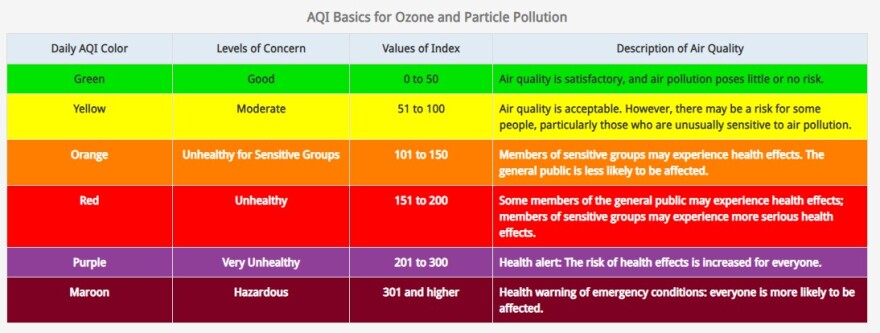BETHLEHEM, Pa. – The latest round of smoke from the Canadian wildfires drifted back into the region Thursday, and will linger Friday.
The state Department of Environmental Protection has issued a code orange air quality alert for the Lehigh Valley — an improvement that eventually will mean it’s “moderately unhealthy” to venture outside, rather than “unhealthy.”
- The Lehigh Valley saw the return of wildfire smoke Thursday and is under a Code Orange air quality alert Friday
- Almost 500 active fires are being reported in Canada, with more than 20 million acres burned
- Experts warn smoke could drift in and out of the region through the summer and into the fall
But that improvement Friday morning was slow to come by, even after forecasters said the direct flow of smoke from the wildfires had largely been cut off as of Thursday evening.
At 5 a.m. Friday, the air quality in Allentown was at 171, or still in the red.
The National Weather Service also said the latest guidance continues to indicate light to moderate smoke conditions persisting throughout the day, quite similar to Thursday, with some degree of improvement in air quality later in the afternoon and evening.
Experts also say this latest round of smoke will not be the last, and that millions should prepare for a summer of smoke.
Why does the smoke keep returning?
On Thursday, the Canadian Interagency Forest Fire Centre reported 497 active fires burning across the country, of which 229 were out of control.
For the first time, the areas burned by wildfires this season also surpassed 20 million acres.
New: the area burned by Canadian wildfires this season has surpassed 20 million acres.
— Matthew Cappucci (@MatthewCappucci) June 29, 2023
Fires are burning in every Canadian province, from Newfoundland to British Columbia. Many of the fires are being monitored, but not fought.
That’s because they’re burning through inaccessible or remote land, officials say. That means as long as there are fires, any change in direction to a northerly or northwesterly wind will blow smoke into the United States.
That pattern could continue into the fall, perhaps through October.
Air pollution levels in the area
Friday will mark the 46th day of the year in which the Lehigh Valley's air quality has been outside the "good" or green category that represents a healthy air quality.
Most days have been ‘moderate’ and a few days have been ‘unhealthy.’ One has been ‘hazardous.’

By comparison, we had 42 days of "moderate" readings, but no days with unhealthy or hazardous readings through the first six months of 2022.
In 2021, we had 38 days of moderate readings by June 30. The year before that, it was 24 days in that period.
Air quality alerts covered all or parts of 23 U.S. states Thursday, and experts warned that the hazy skies will be a repeated hazard we’ll all have to adjust to here on the East Coast.
Formaldehyde in the air?
Unlike what the Lehigh Valley experienced in early June, the smoke and haze that drifted across the region on Thursday lacked that “campfire” smell.
But there are other chemical compounds in the air, including formaldehyde, according to the Michigan Department of Environment, Great Lakes and Energy.
“Wood fires emit a number of volatile organic compounds, which our noses typically pick up,” according to the department.
“But when exposed to UV radiation from the sun, some of these familiar chemical compounds break down, leaving behind others such as formaldehyde, benzene and acrolein.”
If you think Canadian wildfire smoke smells like burning plastic there's a good reason, according to our toxicologists. Looks like our friend @CEaslickWNEM beat us to the post, so let's go with it! https://t.co/NCTvxs1acN
— Michigan EGLE (@MichiganEGLE) June 28, 2023
The EPA said research is ongoing to determine how the wildfire smoke can be linked to specific adverse health outcomes.
Formaldehyde is classified as a “probable human carcinogen," and inhalation exposure can cause respiratory symptoms such as eye, nose and throat irritation, according to the agency.
The latest advice to stay safe
As smoke shrouded the Lehigh Valley in early June, finding an air purifier proved nearly impossible. Now, experts are weighing in on what type of air filters are most effective for residences and businesses as we adjust to smoke being a new normal.
According to reports, people should look for HVAC filters with a Minimum Efficiency Reporting Value rating of 13 or above ― which is listed as “MERV 13” in product descriptions.
It’s a rating as determined by the American Society of Heating, Refrigeration, and Air-Conditioning Engineers, or ASHRAE. It means the filters have been tested and confirmed to effectively remove air pollution and other asthma triggers.
They should carry a “certified asthma & allergy friendly” seal, showing they meet specific standards for allergen reduction.
"Upgrading to a filter rated MERV 13 or higher can be especially important during smoky periods."The EPA
“Upgrading to a filter rated MERV 13 or higher can be especially important during smoky periods to effectively remove fine particle pollution from smoke in the indoor air,” the EPA says on its website.
It notes that most HVAC systems can accommodate this filter without creating equipment problems, as long as the filter is replaced frequently.


